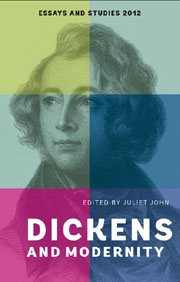Book contents
- Frontmatter
- Contents
- LIST OF ILLUSTRATIONS
- ACKNOWLEDGEMENTS
- NOTES ON THE CONTRIBUTORS
- INTRODUCTION
- 1 THE DICKENS TAPE: AFFECT AND SOUND REPRODUCTION IN THE CHIMES
- 2 DICKENS, SEXUALITY AND THE BODY; OR, CLOCK LOVING: MASTER HUMPHREY'S QUEER OBJECTS OF DESIRE
- 3 TEXTS, PARATEXTS AND ‘E-TEXTS’: THE POETICS OF COMMUNICATION IN DICKENS'S JOURNALISM
- 4 CORPUS STYLISTICS – DICKENS, TEXT-DRIVENNESS AND THE FICTIONAL WORLD
- 5 THINGS, WORDS AND THE MEANINGS OF ART
- 6 DICKENS AND THE CIRCUS OF MODERNITY
- 7 THE OLIVER! PHENOMENON; OR, ‘PLEASE, SIR, WE WANT MORE AND MORE!’
- 8 ‘WOW! SHE'S A LESBIAN. GOT TO BE!’: RE-READING/RE-VIEWING DICKENS AND NEO-VICTORIANISM ON THE BBC
- 9 OUT OF PLACE: DAVID COPPERFIELD'S IRRESOLVABLE GEOGRAPHIES
- 10 AFTERWORD: THE 2012 BICENTENARY
- Index
4 - CORPUS STYLISTICS – DICKENS, TEXT-DRIVENNESS AND THE FICTIONAL WORLD
Published online by Cambridge University Press: 05 February 2013
- Frontmatter
- Contents
- LIST OF ILLUSTRATIONS
- ACKNOWLEDGEMENTS
- NOTES ON THE CONTRIBUTORS
- INTRODUCTION
- 1 THE DICKENS TAPE: AFFECT AND SOUND REPRODUCTION IN THE CHIMES
- 2 DICKENS, SEXUALITY AND THE BODY; OR, CLOCK LOVING: MASTER HUMPHREY'S QUEER OBJECTS OF DESIRE
- 3 TEXTS, PARATEXTS AND ‘E-TEXTS’: THE POETICS OF COMMUNICATION IN DICKENS'S JOURNALISM
- 4 CORPUS STYLISTICS – DICKENS, TEXT-DRIVENNESS AND THE FICTIONAL WORLD
- 5 THINGS, WORDS AND THE MEANINGS OF ART
- 6 DICKENS AND THE CIRCUS OF MODERNITY
- 7 THE OLIVER! PHENOMENON; OR, ‘PLEASE, SIR, WE WANT MORE AND MORE!’
- 8 ‘WOW! SHE'S A LESBIAN. GOT TO BE!’: RE-READING/RE-VIEWING DICKENS AND NEO-VICTORIANISM ON THE BBC
- 9 OUT OF PLACE: DAVID COPPERFIELD'S IRRESOLVABLE GEOGRAPHIES
- 10 AFTERWORD: THE 2012 BICENTENARY
- Index
Summary
Introduction
Accounts of Dickens's language highlight the variety of stylistic devices that can be found in his writings (cf. e.g. Stewart, Plummer). Ingham observes that Dickens ‘deploys every available linguistic resource’ (126). However, relatively little attention seems to have been given to specific patterns and the functions they fulfil in the creation of fictional worlds. This article sets out to illustrate how computer-assisted methods can support the analysis of linguistic devices and the effects they create in the text. The focus will be on two resources in particular: repeated sequences of words and suspended quotations. The strength of computer-assisted approaches is typically seen in the potential that quantification offers, for instance, for the comparison of stylistic features in writings of different authors. The present approach, however, is less interested in the detailed quantification of features than in the functions of the patterns that become visible when a number of examples form the evidential basis for textual analysis. When cues in the text guide an analysis it becomes text-driven. This article will show how links can be made between a text-driven approach and wider concerns in literary criticism – in particular the creation of characters in fictional worlds. I will look at how descriptions of body language contribute to the externalised techniques of characterisation which John has argued are rooted in Dickens's narrative prose. Patterns that are found with the help of corpus methods also relate to linguistic resources that Rosenberg describes as the ‘language of doubt’.
- Type
- Chapter
- Information
- Dickens and Modernity , pp. 94 - 114Publisher: Boydell & BrewerPrint publication year: 2012

